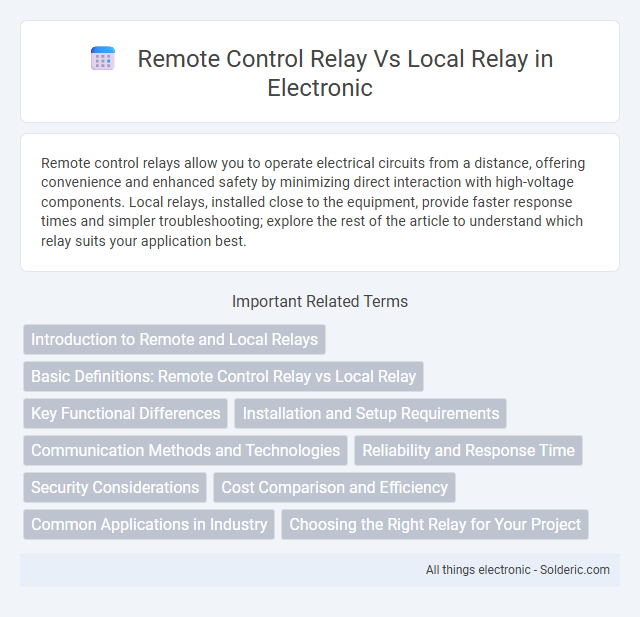Remote control relays allow you to operate electrical circuits from a distance, offering convenience and enhanced safety by minimizing direct interaction with high-voltage components. Local relays, installed close to the equipment, provide faster response times and simpler troubleshooting; explore the rest of the article to understand which relay suits your application best.
Comparison Table
| Feature | Remote Control Relay | Local Relay |
|---|---|---|
| Location of Operation | Operated remotely via network or wireless signals | Operated directly on-site or nearby the controlled device |
| Installation | Requires network or communication setup | Simple direct wiring on local device |
| Control Distance | Long-range control capability | Short-range, typically adjacent device |
| Response Time | May experience slight delay due to network latency | Immediate, low latency response |
| Usage Scenario | Ideal for remote automation, IoT, and system-wide control | Best for direct device control and simple applications |
| Complexity & Cost | Higher complexity and setup cost | Lower complexity and cost |
| Maintenance | Requires network maintenance and monitoring | Simple hardware maintenance |
Introduction to Remote and Local Relays
Remote control relays enable you to operate electrical circuits from a distance, enhancing safety and convenience in complex systems. Local relays function directly at the equipment site, providing immediate response and reliable protection for low-voltage applications. Understanding the distinction between remote and local relays is essential for optimizing control system efficiency and safeguarding your electrical infrastructure.
Basic Definitions: Remote Control Relay vs Local Relay
Remote control relay operates by receiving signals from a distant control point to switch electrical circuits on or off, enabling centralized automation and monitoring. Local relay functions directly at the equipment site, providing immediate response to electrical faults or operational commands for protection and control. Understanding these distinctions helps optimize Your electrical system's efficiency and reliability by selecting the appropriate relay type for either decentralized or centralized control needs.
Key Functional Differences
Remote control relays enable operation and switching of electrical circuits from a distance, facilitating centralized management and automation in industrial and residential systems. Local relays function by directly detecting electrical faults or anomalies within nearby equipment, providing immediate protection and response without reliance on external signals. The key functional difference lies in remote control relays offering accessibility and control over large areas, whereas local relays ensure quick, localized fault detection and circuit interruption.
Installation and Setup Requirements
Remote control relays typically require network infrastructure for installation and configuration, including communication protocols like Modbus or Ethernet/IP, which can increase setup complexity compared to local relays. Local relays offer straightforward installation with direct wiring to control circuits, minimizing the need for additional components or software setup. Installation time for local relays is generally shorter, making them suitable for simple control applications without extensive network integration.
Communication Methods and Technologies
Remote control relays utilize communication methods such as wireless protocols (Zigbee, Wi-Fi, cellular) or wired networks (Ethernet, RS485) for operation over long distances, enabling centralized monitoring and control. Local relays rely on direct electrical connections or short-range communication like hardwired control panels, ensuring immediate and reliable switching within localized systems. The choice between remote and local relays depends heavily on network infrastructure, latency requirements, and the complexity of the control environment.
Reliability and Response Time
Remote control relays may experience slight delays due to communication latency, potentially impacting response time compared to local relays, which operate directly on-site with immediate signal processing. Local relays offer higher reliability by minimizing dependence on network stability, ensuring consistent performance during power system faults. Your choice between remote and local relays should consider the criticality of rapid response and the reliability required for your protection scheme.
Security Considerations
Remote control relays introduce potential security vulnerabilities by relying on network communication, which can be exploited through hacking or unauthorized access. Local relays operate independently and are less susceptible to cyber threats, providing enhanced physical security and reliability. Ensuring proper encryption and authentication protocols when using remote control relays is essential to protect your systems from unauthorized manipulation.
Cost Comparison and Efficiency
Remote control relays often incur higher upfront costs due to advanced communication modules and installation requirements, yet they offer superior efficiency by enabling centralized operation and faster response times. Local relays typically have lower initial expenses and simpler maintenance but may suffer from slower reaction speeds and limited integration capabilities. Your choice depends on balancing budget constraints with long-term efficiency gains in system management.
Common Applications in Industry
Remote control relays are widely used in industrial automation and process control systems for managing equipment and machinery over long distances, enabling centralized monitoring and operation. Local relays are typically employed in electrical panels and control circuits for immediate, on-site switching tasks such as motor starters, lighting control, and safety interlocks. Industries like manufacturing, power distribution, and HVAC rely on a combination of remote and local relays to ensure efficient, reliable operation and quick response to system changes.
Choosing the Right Relay for Your Project
Selecting the right relay for your project hinges on understanding the operational environment and control requirements; remote control relays offer the advantage of flexibility and safety by allowing activation from a distance, ideal for hazardous or hard-to-reach locations. Local relays provide direct, immediate control with simpler wiring and faster response times, suitable for compact setups or where proximity is not an issue. Evaluating factors such as signal type, voltage, current capacity, and installation constraints ensures optimal relay performance and reliability.
remote control relay vs local relay Infographic

 solderic.com
solderic.com